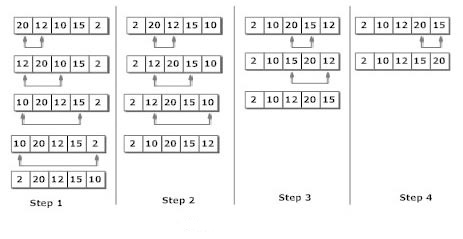選擇排序
在選擇排序中,在每次傳遞中選擇陣列的未排序元素中的最小值,並將其插入到陣列中的適當位置。
首先,找到陣列的最小元素並將其放在第一個位置。 然後,找到陣列的第二個最小元素並將其放在第二個位置。 這個過程一直持續到得到排序的陣列。
具有n個元素的陣列通過使用n-1遍選擇排序演算法進行排序。
在第1遍中,將找到陣列的最小元素及其索引
pos。 然後,交換A[0]和A[pos]。 因此A [0]被排序,現在還有n -1個要排序的元素。在第2遍中,找到子陣列
A[n-1]中存在的最小元素的位置pos。 然後,交換,A[1]和A[pos]。 因此A[0]和A[1]被排序,現在留下n-2個未排序的元素。在第
n-1遍中,找到A[n-1]和A[n-2]之間的較小元素的位置pos。 然後,交換A[pos]和A[n-1]。
因此,通過遵循上述過程,對元素A[0],A[1],A[2],...,A[n-1]進行排序。
執行過程可參考下圖 -
範例
考慮以下具有6個元素的陣列,使用選擇排序對陣列的元素進行排序。
A = {10, 2, 3, 90, 43, 56};
執行排序和交換位置過程如下所示 -
| 遍次 | pos | A[0] | A[1] | A[2] | A[3] | A[4] | A[5] |
|---|---|---|---|---|---|---|---|
| 1 | 1 | 2 | 10 | 3 | 90 | 43 | 56 |
| 2 | 2 | 2 | 3 | 10 | 90 | 43 | 56 |
| 3 | 2 | 2 | 3 | 10 | 90 | 43 | 56 |
| 4 | 4 | 2 | 3 | 10 | 43 | 90 | 56 |
| 5 | 5 | 2 | 3 | 10 | 43 | 56 | 90 |
執行上面排序後,陣列中的資料值如下 -
A = {2, 3, 10, 43, 56, 90}
複雜性
| 複雜性 | 最好情況 | 平均情況 | 最壞情況 |
|---|---|---|---|
| 時間複雜性 | Ω(n) | θ(n^2) | o(n^2) |
| 空間複雜性 | - | - | o(1) |
演算法
SELECTION SORT(ARR, N)
第1步 : 迴圈第2步和第3步,從 K = 1 到 N-1
第2步 : CALL SMALLEST(ARR, K, N, POS)
第3步 : 將 A[K] 與 ARR[POS] 交換
[結束回圈]
第4步 : 退出
SMALLEST (ARR, K, N, POS)
第1步 : [INITIALIZE] SET SMALL = ARR[K]
第2步 : [INITIALIZE] SET POS = K
第3步 : 迴圈 J = K+1 至 N -1
IF SMALL > ARR[J]
SET SMALL = ARR[J]
SET POS = J
[結束IF]
[結束回圈]
第4步 : 返回POS
使用C語言實現選擇排序演算法,程式碼如下所示 -
#include<stdio.h>
int smallest(int[],int,int);
void main ()
{
int a[10] = {10, 9, 7, 101, 23, 44, 12, 78, 34, 23};
int i,j,k,pos,temp;
for(i=0;i<10;i++)
{
pos = smallest(a,10,i);
temp = a[i];
a[i]=a[pos];
a[pos] = temp;
}
printf("printing sorted elements...\n");
for(i=0;i<10;i++)
{
printf("%d\n",a[i]);
}
}
int smallest(int a[], int n, int i)
{
int small,pos,j;
small = a[i];
pos = i;
for(j=i+1;j<10;j++)
{
if(a[j]<small)
{
small = a[j];
pos=j;
}
}
return pos;
}
執行上面範例程式碼,得到以下結果:
printing sorted elements...
7
9
10
12
23
23
34
44
78
101
使用C++語言實現選擇排序演算法,程式碼如下所示 -
#include<iostream>
using namespace std;
int smallest(int[],int,int);
int main ()
{
int a[10] = {10, 9, 7, 101, 23, 44, 12, 78, 34, 23};
int i,j,k,pos,temp;
for(i=0;i<10;i++)
{
pos = smallest(a,10,i);
temp = a[i];
a[i]=a[pos];
a[pos] = temp;
}
cout<<"printing sorted elements...\n";
for(i=0;i<10;i++)
{
cout<<a[i]<<"\n";
}
return 0;
}
int smallest(int a[], int n, int i)
{
int small,pos,j;
small = a[i];
pos = i;
for(j=i+1;j<10;j++)
{
if(a[j]<small)
{
small = a[j];
pos=j;
}
}
return pos;
}
執行上面範例程式碼,得到以下結果:
printing sorted elements...
7
9
10
12
23
23
34
44
78
101
使用Java語言實現選擇排序演算法,程式碼如下所示 -
public class SelectionSort {
public static void main(String[] args) {
int[] a = {10, 9, 7, 101, 23, 44, 12, 78, 34, 23};
int i,j,k,pos,temp;
for(i=0;i<10;i++)
{
pos = smallest(a,10,i);
temp = a[i];
a[i]=a[pos];
a[pos] = temp;
}
System.out.println("printing sorted elements...\n");
for(i=0;i<10;i++)
{
System.out.println(a[i]);
}
}
public static int smallest(int a[], int n, int i)
{
int small,pos,j;
small = a[i];
pos = i;
for(j=i+1;j<10;j++)
{
if(a[j]<small)
{
small = a[j];
pos=j;
}
}
return pos;
}
}
執行上面範例程式碼,得到以下結果:
printing sorted elements...
7
9
10
12
23
23
34
44
78
101
使用C#語言實現選擇排序演算法,程式碼如下所示 -
using System;
public class Program
{
public void Main() {
int[] a = {10, 9, 7, 101, 23, 44, 12, 78, 34, 23};
int i,pos,temp;
for(i=0;i<10;i++)
{
pos = smallest(a,10,i);
temp = a[i];
a[i]=a[pos];
a[pos] = temp;
}
Console.WriteLine("\nprinting sorted elements...\n");
for(i=0;i<10;i++)
{
Console.WriteLine(a[i]);
}
}
public static int smallest(int[] a, int n, int i)
{
int small,pos,j;
small = a[i];
pos = i;
for(j=i+1;j<10;j++)
{
if(a[j]<small)
{
small = a[j];
pos=j;
}
}
return pos;
}
}
執行上面範例程式碼,得到以下結果:
printing sorted elements...
7
9
10
12
23
23
34
44
78
101